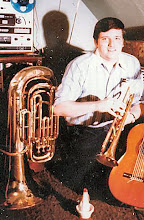 1962 Coral Records EC 81189 Stereo 7" EP
1962 Coral Records EC 81189 Stereo 7" EP
Note, the back cover is blank. This EP was used in juke boxes. Liner notes are excerpts from the LP.
Side One
1. Farewell Blues
2. March Of The Bob Cats
Side Two
1. At The Jazz Band Ball
2. Jazz Me Blues
Liner Notes:
PETE FOUNTAIN and AL HIRT
Personnel:
Pete Fountain, clarinet
Al Hirt, trumpet
Eddie Miller, tenor sax
Jack Sperling, drums
Ray Bauduc, drums
Stan Wrightsman, piano
Morty Corb, bass
Bobby Gibbons, guitar
In recalling the story of New Orleans jazz, historians have dwelt endlessly on the legendary facts and figures of the tenderloin. An ordinance sponsored in 1897 by a local alderman named Story, setting topographical limits on the sporting-house district, led to the birth of an area that was to become known internationally as Storyville, and from then until 1917, when the district was shut down, the events took place that were commemorated in songs about Basin Street and Mahogany Hall.
Less celebrated in the annals of the Crescent City's music is French Quarter's Bourbon Street, a thorough-fare that has become, especially in the past two decades, New Orleans' equivalent of the now-fabled 52nd Street in Manhattan. Long after Storyville's coda was sounded, long after the first jazz pioneers had moved on to Chicago and Los Angeles and New York, Bourbon Street with its nest of small clubs provided a pied-a-terre for dozens of small, bristling combos that kept the city's musical tradition alive.
As you walk down this narrow street, if you know any of the history of Bourbon Street you will sense music in the air, before and after as well as during working hours. Passing by the Famous Door, the Dream Room, Antoine's and all the other sites where jazz has been played, you are reminded of the days when the late Irving Fazola blew his last chorus on the street back in the '40s; of Eddie Miller and the other local men who went on to spread the Dixieland word via the Bob Crosby orchestra; of Louis Prima, Sharkey Bonano, Wingy Manone and the many others for whom Bourbon Street was home.
Pete Fountain and Al Hirt are two symbols of Bourbon Street jazz who in the past few years have carried their message into unexpected channels. Today each leads his own group, bringing the jazz tradition to sophisticated night clubs from Las Vegas to New York and to national television shows. Pete has his own club, the highly successful French Quarter Inn at 800 Bourbon Street, while Al, between national tours, can be found at 600 Bourbon Street, at his and Dan Levy's Pier 600 Club, where he was discovered in 1960.
Some of the music in this EP was recorded when Pete and Al, not yet known to the general public, were working jointly in an exciting little group. March of the Bobcats is a product of this period. This composition, as the credits indicate, was a product of the Bob Crosby band and lends itself ideally to Al's plunging, no-holds-barred horn. The trombone soloist, Abe Lincoln, though born in Lancaster, Pa., is a son of New Orleans in spirit and has recorded with everyone from Bobby Hackett to Bob Scobey. Eddie Miller's warm tenor sound follows, as personal and persuasive as when he was a key Crosby man (1936-42). Solos by Al and Pete are next, the former showing great finesse without the showmanship that was to come later.
On this and the other tunes featuring Al Hirt and Pete, you will hear the remarkably intense beat of a double rhythm section. Stereo listeners will find drummer Jack Sperling on the left; pianist Stan Wrightsman left and center; drummer Ray Bauduc center; bassist Morty Corb center and right; guitarist Bobby Gibbons right.
Farewell Blues, a tune recorded in 1922 by the Friars Society Orchestra, has some inspired muted trumpet by Al followed by some typically fluent Fountain and a solo spot by Stan. Notice how, in the open horn solo before the final ensemble, AI Hirt hints at the iron lip he was to develop as one of his most commercial assets in the next couple of years.
At The Jazz Band Ball again shows off Al's potent lead and reminds us of Stan's elegant qualifications as a real two-handed pianist. Eddie Miller, Al, Pete and Morty all have solos and the ensemble generates a stimulating eight-beat feeling.
Jazz Me Blues, by the Pete-and-Al combine, is taken at a relaxed medium trot and swings consistently with the help of Eddie Miller, Abe
Lincoln and Stan Wrightsman.
As this album attests, you can take the musicians out of Bourbon Street but you can't take the Bourbon Street out of men like Pete and Al. The buoyant, spirited music for which they have become roving ambassadors is a contagiously happy reminder of the street where it lived - and still lives, as often as the Fountains and Hirts have a chance to hurry back home.
- Leonard Feather



No comments:
Post a Comment